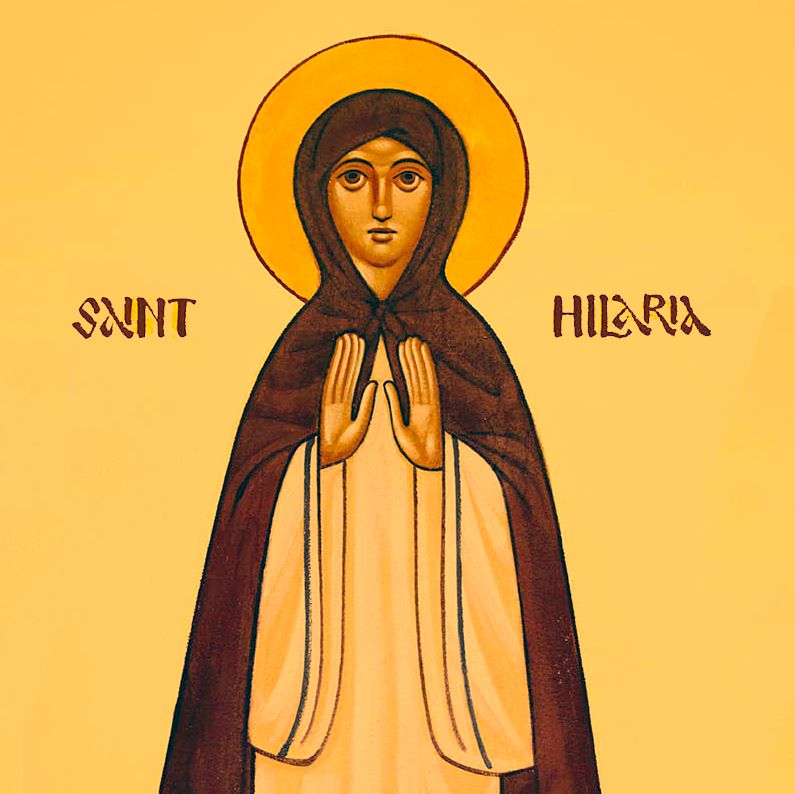
The incredible variety across saints’ lives has kept me in the church. If a princess can grow up to be an honored empress (St. Theophano), a deposed queen (Sts. Alexandra & Valeria), an abbess (St. Elizabeth the New Martyr), or a runaway-turned-monk and in each case find her way to sainthood, then there must be a path to sainthood for me, too. This story is about the princess who ran away to be a monk, one of my favorites.
St. Ilaria was the oldest daughter of Emperor Zeno, whose sons are mentioned in the historical record, but whose daughters are not. Many, then, say Ilaria doesn’t exist. Ah, well, others say the same about St. Catherine. I don’t get the sense that St. Ilaria minds whether we believe in her or not. After all, she treasured her life of obscurity.
In Constantinople, Ilaria grew up surrounded by beauty, luxury, and power. She was well-educated and accomplished. But Ilaria’s parents taught her to love prayer and silence above all. It worked perhaps a little too well. Like many of us, Ilaria prayed for inspiration during the Liturgy, for guidance from the Gospel or Epistle, anything. Unlike many of us, she listened.
In Hebrews: “By faith, Moses refused to be called the son of Pharaoh’s daughter, choosing rather to suffer affliction with the people of God, than to enjoy the pleasures of sin for a season.”
Then in the Epistle: “The wealth of this world is like grass and hay.”
And Acts: “I have coveted no silver or gold or apparel, indeed, you yourselves know that these hands have ministered unto my own needs.”
Psalms: “His joy is sweeter than gold, and precious stones, and honey, and honeycomb.”
And then, the Gospel: “Whosoever does not forsake all that they have cannot be my disciple.”
Even the homily preached by the bishop seemed to be addressed to her, when he said, “Wherefore, O man, do you desire what passes away and what you must leave behind. Know that the lusts of this world pass away. Therefore, do not trust in riches, for our riches remain here while our sins precede us to the judgment-seat of the Lord.” (source)
At the age of 12, Ilaria dressed as an imperial bodyguard and used a stolen signet ring to commandeer a ship to take her to Alexandria.
Once in Alexandria, she prayed in a church devoted to St. Peter, then a church dedicated to St. Mark, then a monastery of St. Menas. She prayed and prayed and prayed. She found a monk called Abba Pambo (though the Abba Pambo lived a hundred years before this), and asked for his help becoming a monastic. He told her to go to Enaton, where life was easier. But if Ilaria had wanted life to be easy, she could have stayed in the palace.
So she made her home in Scetis, and prayed and fasted and fasted and prayed. She lived in a cave and rejoiced in her solitude. When after a few years her beard hadn’t come in (and due to her severe fasting, neither had her breasts), they decided she was Hilary the Eunuch. Abba Pambo knew the truth, but let her stay.
Meanwhile, her beloved younger sister, Theopiste, began to struggle. It’s said she was possessed by a demon, though exactly what that meant has been lost to history.
Having already buried a son and lost one daughter, Theopiste’s parents were desperate. They hired every doctor, offered every reward.
Finally, they sent Theopiste to the monks at Scetis, to the Monastery of St. Macarius, that she might be healed through prayer. The monks were baffled. What are a bunch of celibate, impoverished men to do with a fancy princess and her entourage?
Upon seeing her, the monk Hilary “drenched the ground with a flood of tears” (source). Seeing his strong reaction, they decided this was proof that he was the one who should pray for Theopiste. So they assigned him the job of praying for the sick princess, and even gave him permission to take the princess back to his cell.
The sisters spent seven days together, without Ilaria revealing her true self to Theopiste. She held her and kissed her and slept curled up side by side, as sisters do and monks do not. And on the seventh day, Theopiste was healed.
When Theopiste—fully in her right mind and sound of body—traveled home and greeted her father, he was equal parts joyous and baffled. How did this monk heal you? How did you spend your week together?
The answer had Zeno rightfully concerned. He called for this Monk Hilary to come and explain himself. In some stories, to save face, Zeno pretends to be ill and calls for Monk Hilary to help him.
Ilaria knew her father well. She asked for the Gospels, and had Zeno swear upon the holy book that she’d be allowed to go back to her cave once she had explained everything. She had saved Theopiste, so Zeno agreed.
And so Ilaria revealed herself. She may have shown a birthmark. Everyone cried tears of joy.
She remained in the palace for three months. When she announced her plans to return, the emperor refused to consider it. But she reminded him of his oath, and they agreed to a compromise: Ilaria went home to pray, but her father wrote to the Governor of Egypt, demanding he send grain and oil and all that monks could need–not just once, but many times. The emperor also supported new building projects to create space for new monks. And the new monks came. The number of monastics in the wilderness increased, and increased, and increased.
Ilaria stayed in her beloved desert for a number of years after her return, then departed in peace. Her family cried when they heard, and when the monks washed her body, she shone with joy.
And what of the rest?
Zeno is remembered for his part in the fall of the Roman Empire, as well as for the Henotikon, which he wrote in order to find common ground between the Eastern and Oriental Orthodox churches. For the rest of his life, he supported the monastery that his daughter had committed her life to. And the ancient monastery of St. Macarius remains in use in Scetis today.
Ilaria means joy. It shares its roots with the name Hilary, and the word hilarious. While I have never seen an icon of her, I picture her radiantly gaunt, shining with the joy that is the fruit of her labors. St. Ilaria is celebrated on the Dormition of the Theotokos, the anniversary of St. Ilaria’s repose.
***
http://www.stgeorgeministry.com/holy-women-saint-hilaria/
https://copticcrew.com/pages/st-hilaria-the-daughter-of-emperor-zeno
https://suscopts.org/readings/2023/jan/29/
https://www.tertullian.org/fathers/hilaria_04_coptic.htm
https://www.ccel.org/ccel/pearse/morefathers/files/hilaria_05_longarabic.htm
https://www.ccel.org/ccel/pearse/morefathers/files/hilaria_02_intro.htm
https://ccdl.claremont.edu/digital/collection/cce/id/970/
https://www.messenger.com.ge/issues/2120_june_4_2010/2120_history.html



